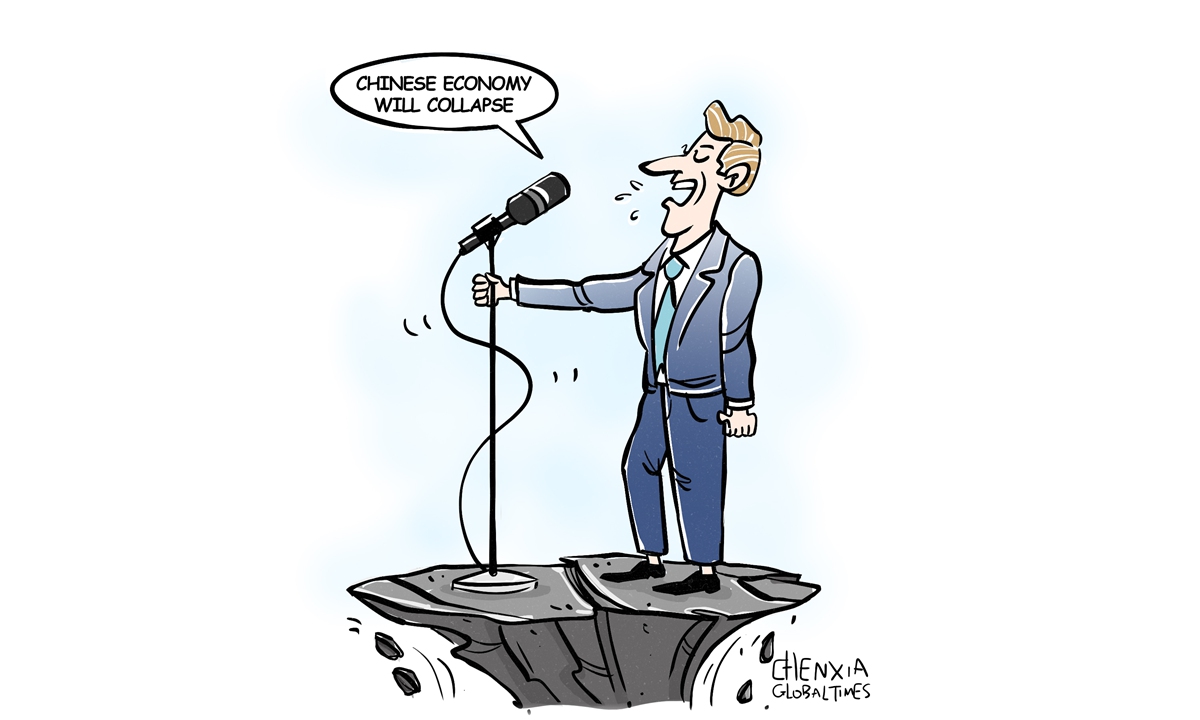
Illustration: Chen Xia/GT
"China still risks Japan's fate despite its manufacturing crown," Bloomberg reported on Saturday. For some time, a narrative has emerged in the West, particularly in the US, suggesting that the Chinese economy is at risk of experiencing a situation similar to that of Japan in the 1990s. However, this misleading perspective is merely another cliche about the "China collapse" narrative that is doomed to fail.This misleading fallacy relies solely on comparing certain superficial aspects of the Chinese and Japanese economies. It fails to recognize the substantial differences between the two nations regarding national conditions, policy approaches, market potential and technological innovation. It also reveals the ulterior motives of certain Western countries that seek to undermine the ongoing development of the Chinese economy.
First, in terms of size and growth, China has a much larger economy than Japan, both in terms of GDP and population. While Japan faced stagnation in the 1990s, China's economy continues to grow steadily at a reasonable pace, addressing the impact of a changing external environment and navigating short-term challenges during its transition toward high-quality growth. This growth provides China with more resources and opportunities to innovate and adapt.
Since 1990, Japan's economic growth has slowed sharply, with GDP averaging 1.3 percent throughout the 1990s. In comparison, China's economy grew by 5.2 percent in 2023 and its potential growth rate is expected to be around 5.5 percent at the current stage, according to calculations by Chinese economists.
Japan's aging population has contributed to its economic stagnation. In contrast, China, despite facing its own demographic challenges, still has a significant portion of its population in the working-age group. This demographic advantage can support economic growth and innovation. According to data from the National Bureau of Statistics, as of the end of 2023, China's labor force was approximately 860 million people.
In addition, with a large and growing middle class, China has a vast domestic market that can drive economic growth. This internal consumption can help buffer against external economic shocks.
Second, from the perspective of macroeconomic regulation and policy approaches, China has a strong ability to implement policies that can stimulate growth and address economic challenges.
China's monetary and fiscal policies are prudent, and the country maintains ample room for maneuver. China has balanced the relationships among short- and long-term goals, stable growth and risk prevention, and internal and external equilibrium, while also strengthening counter-cyclical adjustments.
China has consistently taken proactive measures to prevent and mitigate potential risks as a priority, creating a favorable monetary and financial environment for domestic economic operations.
While some major global economies have adopted irresponsible loose monetary policies or implemented drastic interest rate hikes, causing shocks to the global economy, China has consistently implemented a prudent and moderate monetary policy. Japan's nominal interest rate fell from close to 8 percent in 1990 to close to 1 percent in 1995. In comparison, China has taken a moderate approach to adjusting its interest rates and still has ample room for further adjustments.
Third, with its advantages in the manufacturing sector, China plays a critical role in global supply chains, and its manufacturing capabilities are deeply integrated into the world economy. This position provides China with leverage and resilience that Japan did not have during its economic downturn in 1990s.
Moreover, China is rapidly advancing in technology and innovation, and promoting upgrades of its manufacturing, particularly in areas like artificial intelligence, new energy and telecommunications. This focus on high-tech industries positions China for future growth.
By learning from Japan's experience of a bubble bursting and subsequent stagnation, China can draw lessons from Japan's economic history and implement measures to avoid similar pitfalls. As a result, China is well-positioned to navigate its challenges and maintain sustainable and steady economic growth while transitioning toward high-quality growth.
The author is a reporter with the Global Times. bizopinion@globaltimes.com.cn



